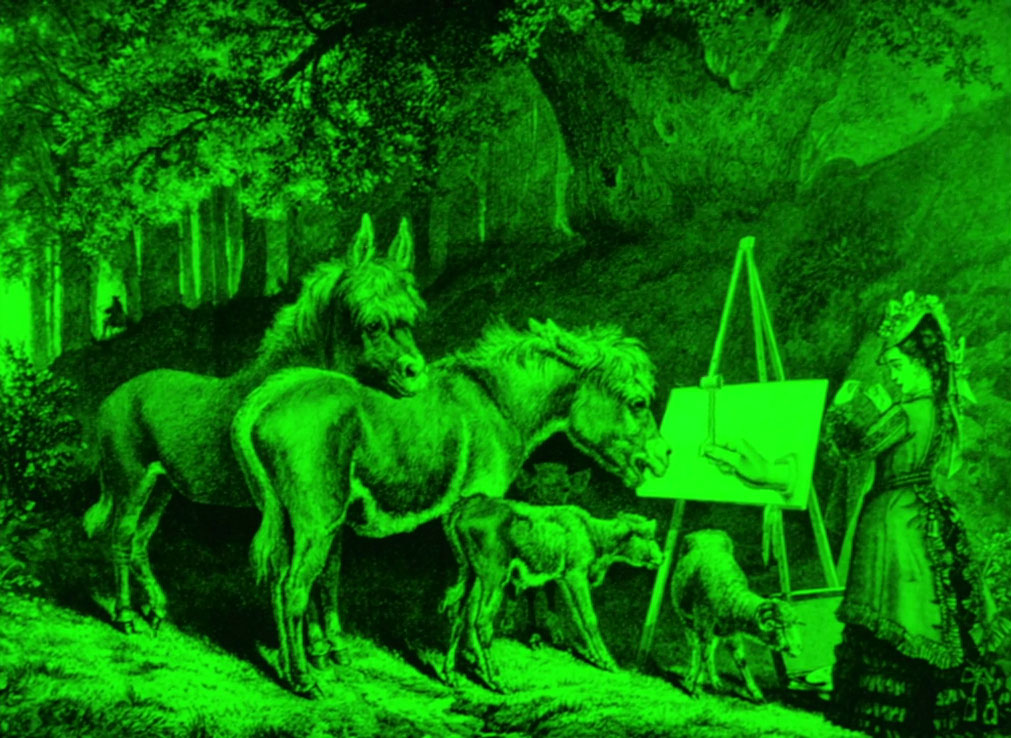A follow-up to last year’s program, with some non-’73 films added for context.
–
Heavy-Light (1973, Adam Beckett)
Video ghosts pong across the screen then engulf it, again and again with different RGBs and forms, sometimes in sync to the electro-spectral music. Adam seems cool – he was an animation pioneer who worked with the Hubleys and on Star Wars, and died young in a fire. Music by Barry Schrader, president of the electro-acoustical music society, who has recently worked with Wadada Leo Smith.
–
Evolution of the Red Star (1973, Adam Beckett)
After a Chairman Mao intro we get rippling pen and paper red/blue line worms slowly blobbing across the screen, the shining red star and other geometrical pulsars holding fast in their spots. In the second half someone seems to be tweaking the settings on their tube TV until the rich color of the red star is restored and takes center stage again. Music by another electro-acoustical pioneer, Carl Stone, whose last few albums made some major top-tens.

–
Diary (1974, Nedeljko Dragic)
Man is walking, then driving, going through as many transformations as the animator can dream up. Party and city scenes, mouse chasing cat, wild color shifts. English words and letters threaten to transform all people into language, but abstract forms win the day, and the man looks miserable about it. Better music than usual, always changing forms to suit the visuals. Won the grand prize at Zagreb.


–
Production Stills (1970, Morgan Fisher)
Simply a film documenting its own making in real-time. We hear the crew working and discussing and see flashes as someone takes polaroids then pins them to the wall in front of the film camera. Reminds me of Michael Snow’s book.
P. Adams Sitney on Fisher: “Very quickly he became the most academically reductive practitioner of minimalist filmmaking … steadfastly resisted the sublime. Instead, he invented cinematic paradoxes.”

–
Picture and Sound Rushes (1973, Morgan Fisher)
Fisher gives a a film technique lecture about picture and sound sync, reading from notes at a desk while an 11-miute timer counts down. We keep losing either sound or picture or both, as he explains why this will happen, breaking down the film’s structure – we lose sound and can’t hear the full description, but we’re also seeing it in action, so we can piece together the missing information. Self-reflexive structural pranksterism – the film is a lecture on itself and a demonstration of its own techniques.

–
The Wilkinson Household Fire Alarm (1973, Morgan Fisher)
One-minute take of a rotating fire alarm which starts spinning then loses momentum like a wind-up toy.

–
De?licieuse catastrophe (1970, Piotr Kamler)
Very blobby 3D scenarios. Person wearing bootleg liquid-engorged optical-illusion sweater engages with the Q-Bert bouncing sphere and plays his horn for a dust sprite until the electro-score gets stuck in a loop and the whole world overflows. The music is by – you’re not gonna believe it – an electro-acoustical pioneer, Robert Cohen-Solal. Kamler was Polish but his whole film career was in France

–
Cours de secours / Heart of Relief (1973, Piotr Kamler)
Ornate cut-out cyclist balancing act upon a tug-o-war rope. Chess players atop the circus stack escape via light-balloon to correct imbalance caused by clockwork romantic pursuit so they can return to their game. Score by Francois Bayle, a “major figure” in electro-acoustical music.


–
Le Pas (1975, Piotr Kamler)
Papery sheets peel off from the gleaming pink surface of a cube and land neatly in a new spot until the entire cube is transposed. A couple sheets stay airborne caressing each other in a film-edit lock-groove but eventually rejoin the cube. The sound is ethereal shimmers by Bernard Parmegiani, whose diverse body of work is mainly dedicated to electro-acoustical music.

–
Orb (1973, Larry Jordan)
Following up Our Lady of the Sphere, more play with cut-out illustrations. Epilepsy-sun becomes balloon, ancient statues join an RGB disco, everything kinda floats away into space.

–
Once Upon a Time (1974, Larry Jordan)
The same colors from the last movie with more direct music and less direct visuals. Narrated story about hearing a bird. Another voice, now it’s a radio play with a woman asking a bird for help finding the missing prince – she locates him in the bardo and says he must be born again.

–
World (1970, Jordan Belson)
Sphere-lens smoke, the universe in a crystal ball. Sunflower spot patterns, TV static eyes, ink-blot anemone. A really good one. Wiki says Belson and Harry Smith got their start at the same time, but it’s Larry Jordan who reminded me of Smith… also says Belson did effects for The Right Stuff, that movie keeps coming up lately. P. Adams Sitney says this one is constrained “by a banal musical soundtrack,” says the abstract geometry recalls Allures.
–
Meditation (1972, Jordan Belson)
Symmetrical spark shower, crashing waves, a human diver, then back into the ether, sphere-blobs slowly becoming other terrains and galaxies, the audio striking bells ringing long notes.
–
Light (1973, Jordan Belson)
Piano score, very water-surface-looking light patterns, then wind, then rising sun. Blooming patterns as the music turns dark and electronic, harp with abstract forms in outer space, finally lens flare leading to fiery apocalypse. Can’t figure out how he did any of this.























